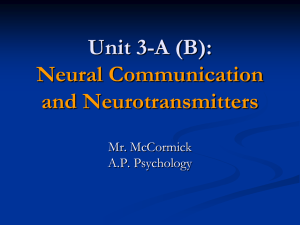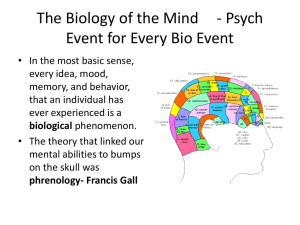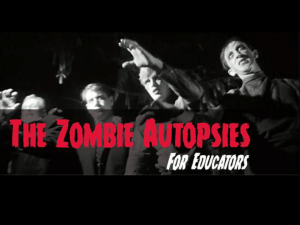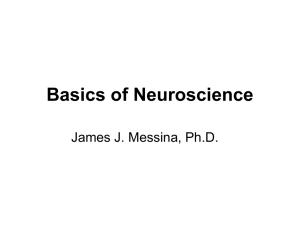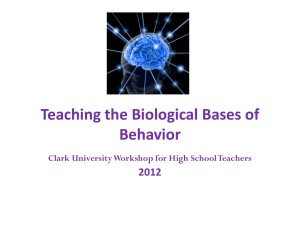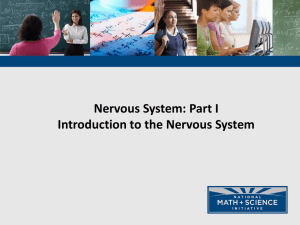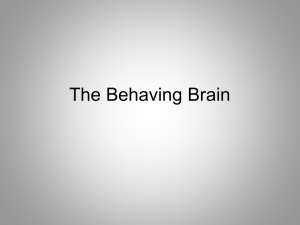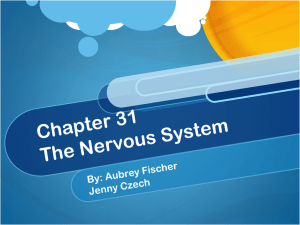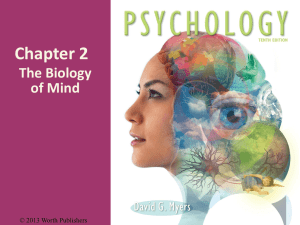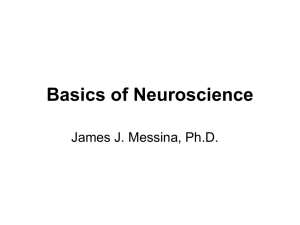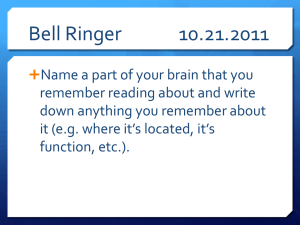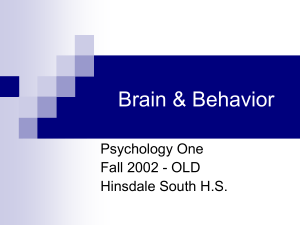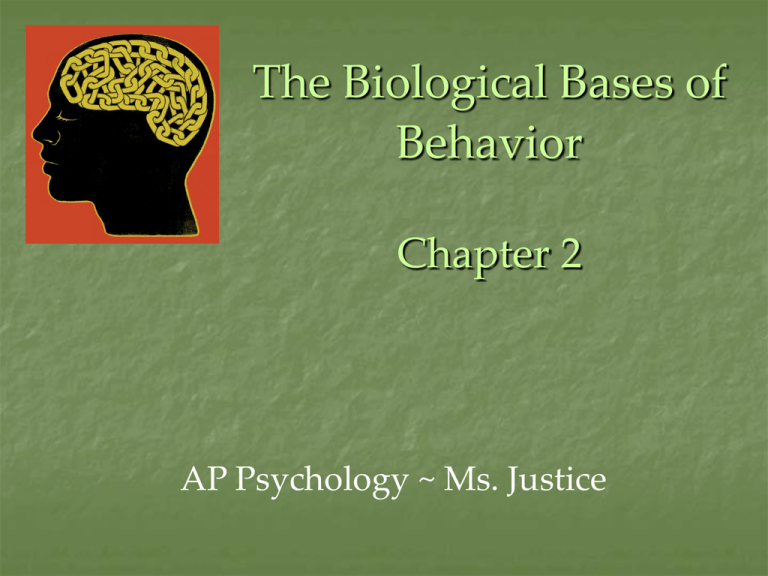
The Biological Bases of
Behavior
Chapter 2
AP Psychology ~ Ms. Justice
BIG IDEAS
Neural Communication
1: What are neurons, and how do
they transmit information?
2: How do nerve cells communicate with other nerve cells?
3: How do neurotransmitters influence behavior, and how do
drugs and other chemicals effect neurotransmitters?
The Nervous System
4: What are the functions of the nervous system’s main
divisions?
The Endocrine System
5: How does the endocrine system transmit its messages?
BIG IDEAS
The Brain
6: How do neuroscientists study the
brain’s connections to behavior and mind?
7: What are the functions of important lower-level brain
structures?
8: What are the functions served by the various cerebral cortex
regions?
9: To what extent can a damaged brain reorganize itself?
10: What do split brains reveal about functions of our two
brain hemispheres?
11: How does handedness relate to brain organization?
1: What are neurons, and
how do they transmit
information?
Neural Communication
The body’s information system is built from
billions of interconnected cells called neurons.
Hi! I’m a
neuron… some
of my friends
call me “nerve
cell”
Neuron
A nerve cell, or a neuron, consists of many
different parts.
Parts of a Neuron
Cell Body: Life support center of the neuron.
Dendrites: Branching extensions at the cell body.
Receive messages from other neurons.
Axon: Long single extension of a neuron, covered with
myelin [MY-uh-lin] sheath to insulate and speed up
messages through neurons.
Terminal Branches of axon: Branched endings of an
axon that transmit messages to other neurons.
Action Potential
A neural impulse. A brief electrical charge that travels
down an axon and is generated by the movement of
positively charged atoms in and out of channels in the
axon’s membrane.
Action Potential
Threshold
threshold: the level of stimulation required to
trigger a neural impulse
Each neuron receives excitatory and inhibitory signals
from many neurons. When the excitatory signals minus
the inhibitory signals exceed a
minimum intensity (threshold)
the neuron fires an action potential…
or if the excitatory party animals
outvote the inhibitory party poopers,
the party’s on.
2: How do nerve cells
communicate with other
nerve cells?
Synapse
Synapse [SIN-aps] - a junction between the axon tip of the
sending neuron and the dendrite or cell body
of the receiving neuron.
This tiny gap is called the synaptic gap or cleft
(which is less than a millionth of an inch wide!)
Neurotransmitters
Neurotransmitters are
chemicals released from the
sending neuron that travel
across the synapse and
bind to receptor sites on the
receiving neuron, thereby
influencing it to generate
an action potential.
Reuptake
Excess neurotransmitters
in the synapse are
reabsorbed into the
sending neurons through
the process of reuptake.
How is a flushing toilet like a neuron firing?
Cat flushing a toilet music video!
How is a flushing toilet like a neuron firing?
•All-or-nothing principle – the toilet either flushes completely or not at all;
it doesn’t flush a little or a lot
•Direction of impulse – the toilet only flushes one way, the impulse can’t
come the other direction (you hope!)
•Refractory period – after you flush the toilet, it won’t flush again for a
certain period of time, even if you push the handle repeatedly
•Threshold – you can push the handle a little bit, but it won’t flush until
you push the handle past a certain point (this corresponds to the level of
excitatory neurotransmitters that a neuron must absorb before it will fire)
•Resting potential –the toilet is waiting to fire, and the water in the tank
represents the overall negative charge inside the neuron waiting for
depolarization
•Action potential – opening the flap in the tank and the water rushing
through the pipes
•Depolarization – represented by the toilet flushing
3: How do neurotransmitters
influence behavior, and how do
drugs and other chemicals affect
neurotransmission?
Lock & Key Mechanism
Neurotransmitters bind to the receptors of the
receiving neuron in a key-lock mechanism.
Drugs and other chemicals affect brain chemistry at
synapses, often by either amplifying or blocking
a neurotransmitter’s activity.
How Neurotransmitters Influence Us
A particular pathway in the brain may only use 1 or 2
neurotransmitters, and particular neurotransmitters
may have particular effects on behavior and emotions:
Serotonin pathways are
involved with mood
regulation.
Dopamine pathways are
involved with diseases
such as schizophrenia and
Parkinson’s disease.
Table 2.1, page 53
Drugs & Other Chemicals
Drugs and other chemicals affect brain chemistry at
synapses
If it is an agonist molecule it will bind
to a receptor and mimic the
neurotransmitter’s effect
Some opiates are agonists and
produce a temporary “high” by
amplifying normal sensations of arousal and pleasure
If it is an antagonist, the molecule will bind to a receptor and
block a neurotransmitter’s function
Poisons like Botulin and Curare can
cause paralysis because they block the
neurotransmitter from sending
signals to the muscles
4: What are the functions of the
nervous system’s main divisions?
Nervous System:
Consists of all the nerve cells. It is the body’s speedy,
electrochemical communication system.
Central
Nervous
System
(CNS):
the brain
and spinal
cord.
Peripheral
Nervous
System
(PNS): the
sensory and
motor
neurons
that connect
the CNS to
the rest of
the body.
The Nervous System
Figure 2.7, p. 55
Peripheral Nervous System
Somatic Nervous System: The division of the peripheral
nervous system that controls the body’s skeletal muscles.
Autonomic Nervous System: Part of the PNS that controls
the glands and other muscles, such as the heart.
Autonomic Nervous System (ANS)
Sympathetic Nervous System: Division of the
ANS that arouses the body, mobilizing its
energy in stressful situations (fight-or-flight).
Parasympathetic Nervous System: Division of
the ANS that calms the body, conserving its
energy (rest and digest).
.
In everyday situations, these two systems work together to
keep you in a steady internal state.
Autonomic
Nervous
System
(ANS)
Figure 2.8, p. 56
Central Nervous System
The brain’s neurons cluster into neural networks.
Neurons networked with each other can have short,
fast connections. Learning occurs as feedback
strengthens connections.
“Neurons that fire together wire together.”
Complex Neural Network
A grain-of-sand-sized speck of your brain contains some 100,000
neurons and 1 billion “talking” synapses!
Central Nervous System
The Spinal Cord and Reflexes
Fig. 2.10, p. 58
5: How does the endocrine
system –the body’s slower
information system- transmit its
messages?
The Endocrine System
The Endocrine System is the body’s “slow” chemical
communication
system.
Communication
is carried out by
hormones
synthesized by a
set of glands.
Figure 2.11, p. 59
Hormones
Hormones are chemicals synthesized by the
endocrine glands that are secreted in the
bloodstream. Hormones affect the brain and many
other tissues of the body.
For example, epinephrine
(adrenaline) increases heart
rate, blood pressure, blood
sugar, and feelings of
excitement during
emergency situations.
Pituitary Gland
Is called the “master gland”
(and is the most influential
endocrine gland). It releases
hormones that influence
growth and its secretions also
influence the release of
hormones by other endocrine
glands.
6: How do neuroscientists study
the brain’s connections to
behavior and mind?
Clinical Observation
Clinical observations have shed light on a
number of brain disorders. Alterations in brain
morphology due to neurological and
psychiatric diseases are now being catalogued.
Tom Landers/ Boston Globe
Electroencephalogram (EEG)
An amplified recording of the electrical waves
sweeping across the brain’s surface, measured
by electrodes placed on the scalp.
AJ Photo/ Photo Researchers, Inc.
PET Scan
Courtesy of National Brookhaven National Laboratories
PET (positron emission
tomography) Scan is a
visual display of brain
activity that detects a
radioactive form of
glucose while the brain
performs a given task.
MRI Scan
MRI (magnetic resonance
imaging) uses magnetic
fields and radio waves to
produce computer-generated
images that distinguish
among different types of
brain tissue.
Top images show ventricular
enlargement in a
schizophrenic patient.
Bottom image shows brain
regions when a participants
lies.
Both photos from Daniel Weinberger, M.D., CBDB, NIMH
James Salzano/ Salzano Photo
Lucy Reading/ Lucy Illustrations
7: What are the functions of the
important lower-level brain
structures?
Older Brain Structures
The brainstem is the oldest part of the brain, beginning
where the spinal cord swells and enters the skull. It is
responsible for automatic survival functions.
The brainstem is also a crossover point, where most nerves
to and from each side of the brain connect with the body’s
opposite side.
Brainstem
The medulla [muh-DUL-uh]
is the base of the brainstem
that controls heartbeat and
breathing.
Helpful mnemonic:
picture an Olympic
athlete wearing gold medals
around her neck and covering
her heart and lungs.
Brainstem
The thalamus [THAL-uh-muss]
is the brain’s sensory
switchboard, located on top of
the brainstem. It directs messages
to the sensory areas in the cortex
and transmits replies to the
cerebellum and medulla.
Hal & Amos are traffic cops….
Brainstem
Reticular formation is a nerve
network in the brainstem that
plays an important role in
controlling arousal.
Cerebellum
The “little brain” attached to the
rear of the brainstem. It helps
coordinate voluntary
movements and balance.
The Limbic System
The limbic system is a
doughnut-shaped system of
neural structures at the
border of the brainstem and
cerebrum, associated with
emotions such as fear,
aggression and drives for
food and sex. It includes the
hippocampus, amygdala,
and hypothalamus.
Amygdala
The amygdala [ah-MIG-dah-la]
consists of two lima bean-sized
neural clusters linked to the
emotions of fear and anger.
Hypothalamus
The hypothalamus directs
several maintenance
activities like eating,
drinking, body temperature,
and control of emotions. It
helps govern the endocrine
system via the pituitary
gland.
Picture a HYPOdermic needle spraying two
thirsty llamas with water to quench their
thirst and cool them down.
Reward Center
Sanjiv Talwar, SUNY Downstate
Rats cross an electrified
grid for self-stimulation
when electrodes are
placed in the reward
(hypothalamus) center
(top picture).
When the limbic system
is manipulated, a rat will
navigate fields or climb
up a tree (bottom
picture).
8: What functions are served by
the various cerebral cortex
regions?
The Cerebral Cortex
The intricate fabric of interconnected neural cells that
covers the cerebral hemispheres. It is the body’s ultimate
control and information processing center.
Figure 2.2, p. 67
Structure of
the Cortex
Each brain hemisphere is
divided into four lobes that
are separated by prominent
fissures. These lobes are the
frontal lobe (forehead),
parietal lobe (top to rear head),
occipital lobe (back of head),
and
temporal lobe (side of head).
Freud
Tore
his
Pants
Off
Functions of the Cortex
The motor cortex is the area at the rear of the frontal
lobes that control voluntary movements.
The sensory cortex (parietal cortex) receives
information from skin surface and sense organs.
Figure
2.24,
p. 69
Visual Function
The functional MRI
scan shows the visual
cortex is active as the
subject looks at faces.
Courtesy of V.P. Clark, K. Keill, J. Ma.
Maisog, S. Courtney, L.G.
Ungerleider, and J.V. Haxby,
National Institute of Mental Health
Auditory Function
A functional MRI scan
shows the auditory
cortex is active in
patients who hallucinate.
Association Areas
More intelligent animals have increased
“uncommitted” or association areas of the
cortex. These areas integrate information, or
link sensory inputs with stored memories
9: To what extent can a damaged
brain reorganize itself?
Phineas Gage
A 19th century American railroad
construction foreman
In 1848, survived of an accident in
which a large iron rod was driven
completely through his head,
destroying much of his brain's left
frontal lobe
The first case suggesting that
damage to specific regions of the
brain might affect personality and
behavior.
Brain and Behavior: Phineas Gage
The Brain’s Plasticity
Plasticity refers to the brain’s ability to modify itself
after some types of injury or illness.
Severed neurons usually do not
regenerate, but some neural tissues
can reorganize in response to
damage.
10: What do split brains reveal
about the functions of our two
brain hemispheres?
Our Divided Brain
Our brain is divided into two hemispheres.
What Does This Dancer Say About You?
Splitting the Brain
A procedure in which the two hemispheres of the
brain are isolated by cutting the connecting fibers:
mainly those of the corpus callosum.
Martin M. Rother
Courtesy of Terence Williams, University of Iowa
Corpus Callosum
Split Brain Patients
With the corpus callosum
severed, objects (apple)
presented in the right visual
field can be named. Objects
(pencil) in the left visual field
cannot.
Divided Consciousness
Try This!
Try drawing one shape with your left hand and
one with your right hand, simultaneously.
BBC
11: How does handedness relate
to brain organization?
Nearly
90% of people are right-handed
More males than females are left-handed
Almost all right-handers (96%), and 70% of left-handers
process speech primarily in the left hemisphere
The remaining 30% of left-handers either process speech in the
right hemisphere or use both hemispheres
Ultrasound observations of thumb-sucking reveal that more
than 9 out of 10 suck the right hand’s thumb
Left-handedness is more common among musicians,
mathematicians, professional baseball players, architects, and
artists






